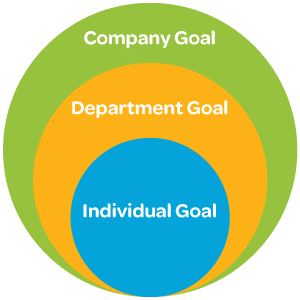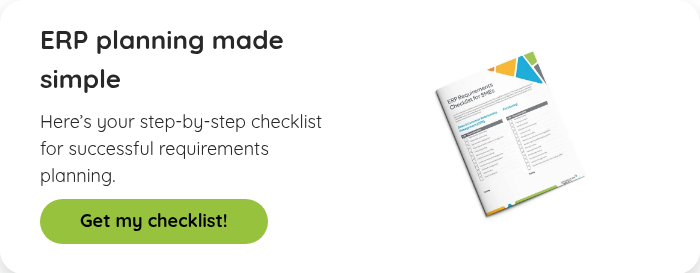Blog
Share this
Define Clear Objectives of ERP Implementation for a Successful Project

by Jalene Ippolito on July 06, 2020
Consider this scenario – an executive walks into the IT person’s office and says, “We need ERP”. The IT person lines up several ERP providers, interviews them on their software functionality and narrows it down to a couple top contenders. Then, based on apparent fit and price, they select their vendor and schedule the implementation project. This is an ERP project that’s doomed to fail. Why? The selection is focused on the technical – what the system can do – instead of letting business need drive the decision.
Considering that about 60% of ERP implementations fail, how can you avoid this situation? You need to carefully consider all aspects of the organization and think about the impact of the implementation on your processes and your people. The shift to a new ERP system can be daunting and disruptive. But it doesn’t have to be. The key is proper foresight and planning.
Imagine if you were to simply plan your building renovation as you go, pushing out a wall here, adding a door there. The supporting infrastructure would be affected each time, and the cost of rerouting electrical systems alone would be much higher than if it were part of an overall design.
Careful planning for changes to and expansion of your software systems is just as important. Without it, you’ll experience unnecessary cost increases as the overall design is reworked. As time goes by you may ask yourself why you’re paying so much for your ERP system!
That’s why it’s so important to define your end-state vision. The more accurately you can define the areas you expect to see improvements, as well as any budgetary constraints, the better equipped you’ll be to review and qualify solutions.
What's the goal of your ERP project?
The most important question to ask yourself and others on your ERP project team is, “What do we want to achieve with ERP?”. Without a clear answer to this question, you won’t be able to properly measure its success. But answering this question isn’t always easy. So, we recommend breaking it down into a few smaller parts that will offer clarity on the bigger question.
Set the overall corporate objective
If you can’t clearly and succinctly answer these questions, it’s less likely that you’ll achieve ERP success. The point of the strategy is to define the objectives of the ERP implementation and define the measurements of success.
- What is the business objective for implementing ERP?
- Have we defined the strategy?
Your objectives will be specific to your business, but here are a few examples to get you thinking. Each one will have its own measurement of success tied to it. It’s not enough to just say ‘Yes, that’s our objective’. Put some numbers to it – if your goal is to speed up invoicing, by how much? If you want better visibility, what does that look like? How will you know you’ve achieved the objective?
- Are we looking to speed up invoicing and collections processes?
- Is customer satisfaction currently suffering because of long response times to customer requests?
- Do we need improved visibility throughout the organization?
- Do we want to gain a better understanding of profitability on each job or project we undertake?
- Do we need improved capacity planning capability to better understand and allocate resources?
- Are we looking to improve accuracy when billing clients to make sure we’re not missing billable expenses?
- Do we want to save money by reducing our inventory?
- Do we need to better manage backorder procedures, or better yet, reduce the frequency of backorders altogether?
- Are we already using ERP but need to upgrade to a more robust and flexible system that will handle the changing needs of our business as we grow?
Consider how ERP contributes to individual objectives
 Getting meaningful measurement on the success of your project isn’t just about the big company objective. You also need to understand how the ERP implementation contributes to the individual objectives of each functional group within your organization. Think of it like a tiered approach – there’s one big goal you want to achieve as a company. But to get there, each department will have goals specific to their function that contribute to the company goal. And each individual person will have goals that contribute to their department objective and therefore to the company objective.
Getting meaningful measurement on the success of your project isn’t just about the big company objective. You also need to understand how the ERP implementation contributes to the individual objectives of each functional group within your organization. Think of it like a tiered approach – there’s one big goal you want to achieve as a company. But to get there, each department will have goals specific to their function that contribute to the company goal. And each individual person will have goals that contribute to their department objective and therefore to the company objective.
Define how you’ll measure success of the ERP project
Here are a few questions to ask among your team before you move forward to the next phase of your ERP evaluation:
- Have we identified the objectives we’re trying to achieve?
- Can we put a value on the objective, if successful?
- Is it possible to achieve the objective without ERP, in a reasonable timeframe?
- Is there a deadline that we’re trying to meet with the ERP implementation?
Don’t forget that some objectives may not have a measurable contribution. Things like improved visibility or reduced business risk may not be quantifiable in dollars but they do contribute to the overall success of the company and the ERP implementation.
Once you’ve identified the metrics you’ll use to measure success, make note of your current KPIs (Key Performance Indicators). This will give you a benchmark to compare against after your new system is implemented. For example, if one of your objectives is to reduce the time it takes to collect payment from customers, be sure you know what your days sales outstanding is before your ERP implementation. Then you’ll have something to compare to after you’ve been running your new system for a few months.
Do your current processes contribute to your objectives?
Now that you have a clear picture of your objectives, it’s time to look at the more functional requirements. You want to understand clearly and fully what the day-to-day processes look like for your people, and what they need to execute efficiently. Be sure to consider more than just the functionality your teams need. It’s equally important to look at the way they consume data and interact with the system.
Think about the various departments and users in your organization. Ask yourself:
- Do we fully understand our existing processes across all areas of the business?
- Have we talked with employees about their daily activities? What’s their user role? What kind of processing power do they need to work effectively?
- What are the roadblocks our employees face with our current systems?
- Can we (or our employees) identify areas where we need improvement?
Once you’ve answered these questions, you’ll be able to recognize a good ERP fit when you see it and clearly communicate your needs when talking with implementation partners.
Share this
Stay in the Know!
Join other SMEs who receive our monthly ERP insights, tips and best practices.
You may also like

ERP Funding for Canadian Businesses

Should You Work with a NetSuite Implementation Partner or Go Direct?



